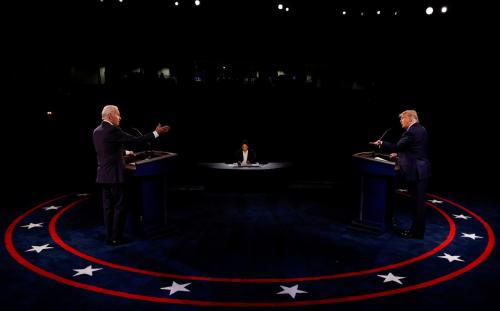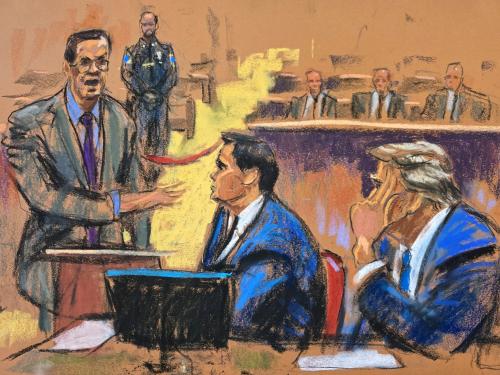The partisan-tinged flags flying over Supreme Court Associate Justice Samuel Alito’s and his wife’s residences is one of the latest dings to the Court’s public image. January 2021 photos surfaced recently of their suburban Washington, D.C. home with an upside-down U.S. flag, as did more recent photos of their beach home showing a Revolutionary era “Appeal to Heaven” flag. Both banners are associated with “stop the steal” 2020 election protestors.
Alito stated that the flag-flying was not his doing but rather his wife’s exercise of her First Amendment rights, that he requested her to lower the flags, and that he was unaware at the time of some details of either incident. His letter, especially when considered alongside his explanations to various news outlets, have received a flood of commentary and at best a mixed reaction (some welcomed his explanation but questioned his rationale for not recusing, while others defended Mrs. Alito’s First Amendment rights and saw recusal demands as part of an effort to sideline conservative justices).
The controversy has led some to maintain that Alito should have recused himself from two pending Supreme Court January 6 related cases. Separately, some have characterized the flag-flying as misconduct. My purpose here is not to sort out the facts of the matter but rather to disentangle some of the confusion over means in place and what more could be done to deal with Supreme Court recusal requests and misconduct allegations.
Recusal
Recusal1 is a judicial decision and typically plays out in one of two ways. The judge can, on his own, recuse himself from the case because of a conflict of interest. Or a party in the case can file a motion seeking the judge’s recusal. If the judge denies the motion, or if evidence of a conflict arises later, the party can raise the issue on appeal. But there is no court to which a party can appeal a Supreme Court justice’s recusal or lack thereof.
Demands for Alito’s recusal have played out Kabuki style. Along with numerous commentators, two Senate Judiciary Committee Democrats asked the chief justice to effect Alito’s recusal from the January 6-related cases and to meet with them about Supreme Court ethics, no doubt aware that neither the recusal nor the meeting were in the cards. The chief justice has no way to cause another justice’s recusal save by persuasion—good luck there—and he rejected the request for a meeting, citing simply “[s]eparation of powers concerns and the importance of preserving judicial independence” and the additional fact that the meeting would not be bipartisan.
Alito, responding to the senators directly, said he alone would decide the matter and that the Court’s November 2023 Code of Conduct requires recusal only when “an unbiased and reasonable person who is aware of all the circumstances would doubt that the Justice could fairly discharge his or her duties.” Alito then recited his version of the flag incidents and announced that the Code’s “unbiased and reasonable person [and he added, perhaps accusing the senators of bad motives, a person “not motivated by . . . a desire to affect the outcome of Supreme Court cases”]. . . would conclude that this event” did not meet the recusal standard. So, he was “duty-bound to reject your recusal request.”
The Court’s Code of Conduct is not law but rather contains the nine justices’ collective interpretation of how the federal law of judicial disqualification applies to them, given their court’s unique situation whereby another judge cannot substitute for a recused justice in order to avoid a possible four-four tie vote. Alito didn’t explain whether a reasonable person knowing all the facts would conclude that federal law demanded that he recuse, potential tie vote notwithstanding.
Alito has been more public than other justices in responding to criticism of decisions and gifts of travel. That he explained his recusal denial, however—whether or not adequately—may suggest that even he realizes the precarious state of the Court’s public standing and the possible further damage that could result from ignoring or responding cursorily to a request from two Senate Judiciary leaders.
Whether judges should explain recusal decisions is one of long standing debate and a hot topic as to the Supreme Court, meriting discussion in the 2021 report of the president’s Supreme Court Commission and in a 2023 letter from the justices to the Senate Judiciary Committee. Justices rarely explain their denial of recusal motions filed by parties (none have been filed in the January 6 cases). Then-Associate Justice Rehnquist did so in 1972 but cautioned that a judge explaining the reasons for denying such motions, except “in the peculiar circumstances” of that case, would not be “desirable or even appropriate.” Thirty-two years later, Justice Scalia explained why he denied a disqualification motion.
As rare as are explanations for denying disqualification requests filed by parties, even rarer—but not unheard-of—are explanations in cases where no party has filed such a motion, as in the present case.
This specific controversy opens another window into Supreme Court recusals. In responding to the senators’ request that he somehow take Alito off the January 6 cases, Roberts simply recited “the practice we have followed for 235 years pursuant to which individual justices decide recusal issues.” This “we’ve-always-done-it-that-way” posture reenforces the Court’s 2023 dismissal, apparently sight unseen, of exploring other ways to deal with Supreme Court recusal, at least had a party filed a motion. (A state appellate rule and a proposed federal bill would have the motion referred to the whole court.) If the Court is disinclined to entertain alternatives to individual decision-making on disqualification motions, it certainly won’t take on the thornier problem of widespread public calls for recusal, albeit without a motion by a party, reluctant as most litigants are to risk offending a justice by filing one.
Misconduct
Although Alito’s non-recusal has caught most of the attention, there is a separate question of whether the Alito flag-flying is judicial misconduct. As explained above, a federal judge’s failure to recuse, even if mistaken, is not misconduct; it’s a judicial decision, subject to remedy on appeal. Judicial decisions are outside the jurisdiction of most judicial conduct regulating regimes.
The Alitos’ flag-flying, however, might merit inquiry even were the January 6 cases not pending. But the facts of the incident are hardly settled; the reporter who broke the stories has explained “that we don’t know everything about when or by who these flags were raised.” The Alito incident would benefit from a way to pin down the facts, which so far has been left to reporters and others who lack authority to issue subpoenas and take testimony under oath.
Had a similar flag situation arisen while Alito were still a court of appeals judge, there would no doubt be a complaint and investigation under the Judicial Conduct and Disability Act. The Act provides a process for filing complaints against “a federal judge” and for determining whether the complained-about conduct occurred and meets the statutory standard of “conduct prejudicial to the effective and expeditious administration of the business of the courts.” The rules for implementing the statute give examples, including “engaging in partisan political activity or making inappropriately partisan statements.”
The 1980 statute is no help in the present case, however, because its definition of “federal judge” does not include Supreme Court justices. To fill that gap, the bill referenced earlier would also establish a judicial complaint mechanism, designating as fact-finders five judges drawn randomly from the 13 chief judges of the federal judicial circuits. The presence of such a mechanism might provide reassurance that there are means of evaluating Supreme Court misconduct claims, although the inevitable flood of often-crackpot complaints might undermine further public confidence in the Court, suggesting caution as to next steps (see Geyh statement here at p.68). Cautious examination, though, is different from Justice Alito’s 2019 opinion that having “lower court judges . . . review. . . things done by Supreme Court Justices for compliance with ethical rules” is “inconsistent with the constitutional structure.” That is an unexamined assertion as far as I can tell. Others have objected that the bill would create an “investigative panel of lower court judges to preside over their bosses on the Supreme Court,” evidently unaware that the current judicial conduct law allows committees that include district judges to investigate and impose sanctions on their “bosses” on the courts of appeal.
Of course, speculation about what might be done—about recusal rules changes or a parallel judicial conduct complaint procedure for justices—is no more than that. Congress will not enact the legislation, and the Court is unlikely to do more than rest on its November 2023 ethics code. But the Alito flag-flying matter is surely not the last incident that will prompt debate on whether more is needed. Along with information about Justice Clarence Thomas’ extravagant and only recently reported trips and other gifts from a wealthy donor, this instance is one further example of a Supreme Court facing some serious controversies about its members’ behavior.
-
Footnotes
- Technically, “recusal” refers to a judge’s removing herself from a case on her own volition. “Disqualification” means a judge’s removal by some other entity. Increasingly, the terms are used interchangeably, as here.







Commentary
The Alitos’ flag flying and the limits of regulating the Supreme Court
June 20, 2024